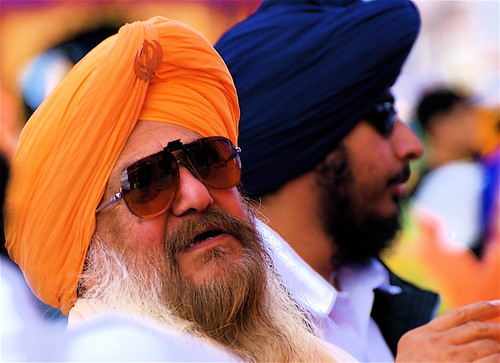
Two Sikh men sport colourful turbans, also known as dastars. The Dastar competition is meant to celebrate Sikh culture and dispel myths about the headwear.
Photo: Patrick Doheny (flickr commons)
Celebrate Sikh culture and see how you look in a turban at this year’s 10th annual Dastar competition.
The free event, held April 6 at the Grand Taj Banquet Hall in Surrey, is meant to dispel misconceptions about the dastar — also known as the turban — and to encourage younger Sikhs to don the traditional headwear.
Turban wearers misjudged
"We wanted to make people aware of the differences between the Sikhs [and others who wear turbans],” said contest organizer Gurdial Badh, director of Sher-E-Punjab Radio. “There’s a lot of misjudgment that we’re all Muslims.”
The 9/11 connection
Badh said that the event was inspired by 9/11, which led to widespread violence towards turban wearers.
Anyone wearing a turban was looked upon as someone they’re not,” said Badh, who mentioned that turban wearers were beaten and even shot after 9/11.
Positive impact in the community
Badh said that the contest has had positive impacts in the South Asian community, noticing that youth wear their turbans more proudly after the event. “It’s just confidence,” said Badh. “Once they see that it’s an acceptable form of uniform, part of your faith, people seem to embrace it, especially youth.”
The event will also feature local talent, including singers and bhangra dancers. Badh said that several popular artists got their start at past Dastar competitions, such as pop singer Jazzy B. “Probably at least 10 to 15 have been discovered here in the Lower Mainland and now they’re big stars back home and here,” said Badh.
Biggest turban tying competition in the world
The Dastar competition is one of the biggest in the world, and the “one that started it” according to Badh. Competitions have been held in such places as New York, Australia, and the UK.
This year’s competition features 20 categories based on age, gender, and turban styles. Badh said that most participants are in their late teens to mid 30’s, but all age ranges are represented in the contest, which normally has 25 to 30 participants in each category.
The event also features apparel-based contests, giving awards in such categories as “best cultural dressed child,” “most unique turban” and “most matching couple.” The latter is a new competition added this year.
Event for everyone
We’re always trying to come up with new ways to get others, especially non-Sikhs to come,” said Badh.
Badh said that many non-Sikhs come to the event and have turbans tied, but none have entered the contest.
But Badh said he welcomes anyone to try their hand at tying.
"[The event] is marketed toward everybody,” said Badh. “You could say it’s marketed toward non-Asians so they can understand the meaning of the dastar.”
"I want to encourage everybody, south Asian and non Asian to come out and partake.”
